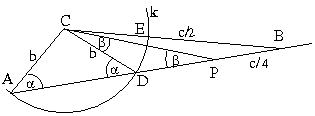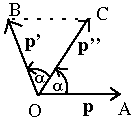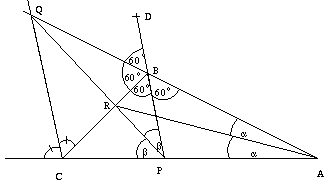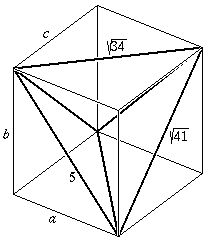Solutions for problems "B" in September, 2000
In this page only the sketch of the solutions are published; in some cases only the final results. To achieve the maximum score in the competition more detailed solutions needed.
B. 3382. The sum of the squares of 17 different positive prime numbers is again a perfect square. Prove that the difference between the squares of the two largest numbers is divisible by the smallest one. (3 points)
Proposed by: A. Gyurcsek, Veszprém
Solution. Dividing a perfect square by 3, the remainder is 0 or 1. Thus, if the sum of 17 perfect squares is another perfect square, then one of the terms is divisible by 3. This implies that one of the 17 prime numbers is 3, and the smallest one is 2 or 3. The two largest primes are not divisible by 2 or 3; they are congruent to 1 modulo 6. So, the difference between the squares of the two largest numbers is divisible by both 2 and 3.
B. 3383. In a right angled triangle, sa and sb denote the medians that belong to the legs of the triangle, the median belonging to the hypotenuse is sc. Determine the maximum value of the expression  . (3 points)
. (3 points)
Proposed by: Á. Besenyei, Tatabánya
Solution.

By Pythagoras' theorem
sa2=(a/2)2+b2,
sb2=b2+(a/2)2,
and from Thales' theorem
sc=c/2.
By the inequality of the arithmetic and quadratic mean values,

and

Equality holds if and only if a=b.
B. 3384. Prove that if a, b, c>0, then
 (3 points)
(3 points)
Proposed by: M. Ábrány, Beregszász
Solution. We prove inequalities  ,
,  and
and  . The sum of them is the statement of the
problem.
. The sum of them is the statement of the
problem.
By the cyclic simmetry it is sufficient to prove the first inequality. This
can easily be transformed to  , which
always holds.
, which
always holds.
B. 3385. The sides of a triangle ABC satisfy BC=AC+ AB. Point P divides side AB in the ratio 3:1. Prove that
AB. Point P divides side AB in the ratio 3:1. Prove that  PAC=2(
PAC=2( CPA). (4 points)
CPA). (4 points)
Solution. Consider the circle k of center C and radius b. Denote the intersection of k and AB by D, the intersection of k and CB by E.

Let k(B) be the power of point B with respect to circle
k. Then
k(B)=BE.(BE+2b)=c/2(c/2+2b)=BD.BA=BD.c.
This implies BD=b+c/4, so
PD=BD-c/4=b and DC=b; thus
PD=DC, the triangle PDC is an isosceles triangle and
finally  =2
=2 .
.
B. 3386. 2001 points are given in a 5x5x10 rectangular box. Prove that there are two of them whose distance is not greater than
 . (4 points)
. (4 points)
Proposed by: M. Ábrány, Beregszász
Solution. Decompose the box into 2000 cubes, their edges are length
of 0.5. There is a cube which contains at least two points. The distance
between these points is at least  .
.
Remark. The 
 0,866 can be improved, see problem A. 242..
0,866 can be improved, see problem A. 242..
B. 3387. Determine the angle  if, for some nonzero vector p, the sum of p and
the vector obtained from p by rotating it by 2
if, for some nonzero vector p, the sum of p and
the vector obtained from p by rotating it by 2 equals to the vector obtained from p by rotating it by
equals to the vector obtained from p by rotating it by
 . (3 points)
. (3 points)
Solution.

For the special case 0o< <180o, the configuration is
shown in the figure. OA=OC=OB. The quadrilateral
OABC is a paralelogramma, AC=OB, so triangle OAC
is equilateral. Thus
<180o, the configuration is
shown in the figure. OA=OC=OB. The quadrilateral
OABC is a paralelogramma, AC=OB, so triangle OAC
is equilateral. Thus  =60o. The
=60o. The  can be
can be  60o+k.360o, where k is an arbitrary integer.
60o+k.360o, where k is an arbitrary integer.
B. 3388. In a triangle ABC, the angle at vertex B
measures 120o. The bisector of this angle
intersects side AC at point P. The bisector of the exterior angle
at vertex C intersects line AB at Q, and finally, segment
PQ intersects side BC at R. Find the measure of  PRA. (5 points)
PRA. (5 points)
Proposed by: S. Katz, Bonyhád
Solution.

First, consider triangle CPB. QBC =180o-120o=60o. Extend PB to
an arbitrary point D. DBQ
=180o-120o=60o. Extend PB to
an arbitrary point D. DBQ =60o, thus BQ is a
exterior angle bisector of triangle BCP. The same holds also for
CQ; connecting their intersection Q with P, we obtain an
angle bisector. Thus CPQ
=60o, thus BQ is a
exterior angle bisector of triangle BCP. The same holds also for
CQ; connecting their intersection Q with P, we obtain an
angle bisector. Thus CPQ =BPQ
=BPQ :=
:= .
.
Now, consider triangle BPA. The BR and PR are exterior
angle bisectors, RA is an angle bisector, thus BAR =PAR
=PAR :=
:= . CPB
. CPB is an exterior angle of triangle PAB so 2
is an exterior angle of triangle PAB so 2 =60o+2
=60o+2 ,
,  =30o+
=30o+ .
.
BPA =180o-(60o+2
=180o-(60o+2 )=120o-2
)=120o-2
PRA =180o-(
=180o-( +(120o-2
+(120o-2 )+
)+ )=180o-(30o+
)=180o-(30o+ +120o-2
+120o-2 +
+ )=30o.
)=30o.
By the solution of Anna Lovrics
B. 3389. Define  , where
each surd contains n square root signs. How many different real numbers
belong to the set
, where
each surd contains n square root signs. How many different real numbers
belong to the set  ? (4 points)
? (4 points)
Solution. Let  . We prove
inductively that the set Gk
contains exactly 2k-1 elements, and they
lie in the interval (0,2).
. We prove
inductively that the set Gk
contains exactly 2k-1 elements, and they
lie in the interval (0,2).
In the case k=1, the only element of Gk=H1 is  , thus our statement is true.
Suppose that the statement holds for some k; from this we prove it for
(k+1) as well. Decompose the set Gk+1 intu three subsets:
, thus our statement is true.
Suppose that the statement holds for some k; from this we prove it for
(k+1) as well. Decompose the set Gk+1 intu three subsets:

By the induction, the middle term has 2k-1 elements in interval  ; the third term has the same number of elements in interval
; the third term has the same number of elements in interval
 . These intervals are disjoint and subsets
of interval (0,2). Thus the number of all elements are
. These intervals are disjoint and subsets
of interval (0,2). Thus the number of all elements are
1+(2k-1)+(2k-1)=2k+1-1.
B. 3390. In a certain tetrahedron, each vertex is incident to
three edges of length 5,  and
and  , respectively. Determine the length of each
segment between the midpoints of some two opposite edges of the tetrahedron. (5
points)
, respectively. Determine the length of each
segment between the midpoints of some two opposite edges of the tetrahedron. (5
points)
Solution. It is easy to see that the opposite edges have equal lengths. This implies that the tetrahedron can be inscribed into a rectangular box.

Denote the lengths of the box' edges by a, b and c. By Pythagoras' theorem
a2+b2=25, b2+c2=41 and c2+a2=34.
From this system we obtain a=3, b=4 and c=5. The distances between the midpoints of the opposite edges of the tetrahedron are the same.
B. 3391. When Bob, holding his valid reserved ticket, entered the railway carriage, he found, to his utmost surprise, that all the 78 seats had already been occupied. In fact, Dan entered the carriage without a reservation, and the other 77 passengers, including Jim, though having a valid reservation, not necessarily sat on the seats they had booked. Bob immediately asked the passenger occupying his seat to find another seat for himself. Next, the passenger who had to stand up went to his own reserved seat, and so on until Dan got exposed. What is the probability that Jim could remain seated all along? (5 points)
Solution. We assume that the passengers choose their seats randomly, so the probabilities of all possible cases are the same.
Group the possible cases into pairs by the following rule: let each pair contain two cases which differ in only the seats of Jim and Dan, which are exchanged.
Consider a possible case when Dan remains seated. In the pair of this case, Dan has to stand up only after Jim, so Jim must stand up.
Now consider a case when Jim must stand up. In the chain of the passengers which must stand up, Dan is after Jim. If they exchange their seats, Dan will be before Jim and Jim remains seated.
Thus, in each pair, in one case Jim must stand up, in the other case Jim remains seated. The probability that Jim could remain seated is exactly 1/2.
Remark. The solution can be explained in a little different way. If we change the problem such that neither Dan, neither Jim has a valid reservation, the story ends when one of them gets exposed; in the 50% of the cases Dan, in the other 50% Jim.
